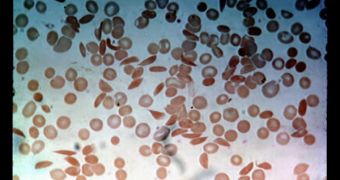Researchers at the Massachusetts Institute of Technology (MIT) and their collaborators announce the creation of a microfluidic device capable of measuring the blood flow of patients diagnosed with sickle cell disease, a very severe condition of the circulatory system.
People suffering from SCD exhibit a specific mutation on the hemoglobin protein that makes their red blood cells crescent-shaped, rather than rod-shaped, as is normal. What this does is prevent the regular, smooth flow these cells usually display when passing through capillaries.
This turbulent flow clogs the smallest blood vessels in the body, leading to a wide array of extremely serious complications, including major organ failure, chronic and severe pain, and a shortened lifespan.
Despite advancements made over the past 60 years in understanding how this condition operates, scientists have been unable to come up with an effective course of treatment to eliminate it.
However, there are some steps that can be taken to ensure increased quality of life for patients. The new microfluidic device developed by the MIT group is able to determine which people are at an increased risk of suffering complications associated with SCD.
As a side note, it's very interesting that SCD may in fact be an evolutionary adaptation that helps people in tropical climates fight malaria. The condition kills about 1 million people every year.
“We still don’t have effective enough therapies and we don’t have a good feel for how the disease manifests itself differently in different people,” research scientists and study team member Sangeeta Bhatia explains.
She holds an appointment as the John and Dorothy Wilson professor of health sciences and technology, and electrical engineering and computer science, at MIT. Her group worked closely with colleagues at the Harvard University, Massachusetts General Hospital (MGH) and Brigham and Women’s Hospital.
Details of how the device works appear in the March 1 issue of the esteemed journal Science Translational Medicine.
“With sickle cell disease, despite patients having the same underlying genetic change, some suffer tremendously while others don’t – and we still don’t have a test that can guide physicians in making therapeutic decisions,” Bhatia explains.
She adds that the microfluidic devices are built in such a way that they exhibit reduced oxygen concentrations within. This causes the blood flow to become turbulent, and allows sickle-shaped red blood cells to clog the small channels.
Scientists then measure how long it takes for the blood flow to stop once the oxygen is removed. This “provides an objective way of assessing new drugs that hopefully will continue to be developed to inhibit the sickling of red blood cells,” says Franklin Bunn.
The expert, who holds an appointment as the director of hematology research at Brigham and Women’s Hospital, was not part of the new investigation.

 14 DAY TRIAL //
14 DAY TRIAL //